Reflective Essay: Addressing the Wound Management Education Gap
VerifiedAdded on 2023/04/07
|5
|891
|287
Essay
AI Summary
This essay is a reflective account by a nursing student focusing on a perceived gap in wound management education. The student employs Driscoll's model of reflection to analyze their nervousness and lack of confidence during practical sessions related to wound care, despite having theoretical knowledge. The reflection highlights the importance of practical experience, proper sterilization techniques, and multidisciplinary approaches in wound management. The student acknowledges that this knowledge gap could potentially affect their future performance as a nursing professional. To address this deficiency, the essay proposes an action plan involving discussions with nursing educators, implementation of wound management policies, and hands-on practice in healthcare settings. The ultimate goal is to enhance competence, confidence, and efficiency in providing high-quality wound care.
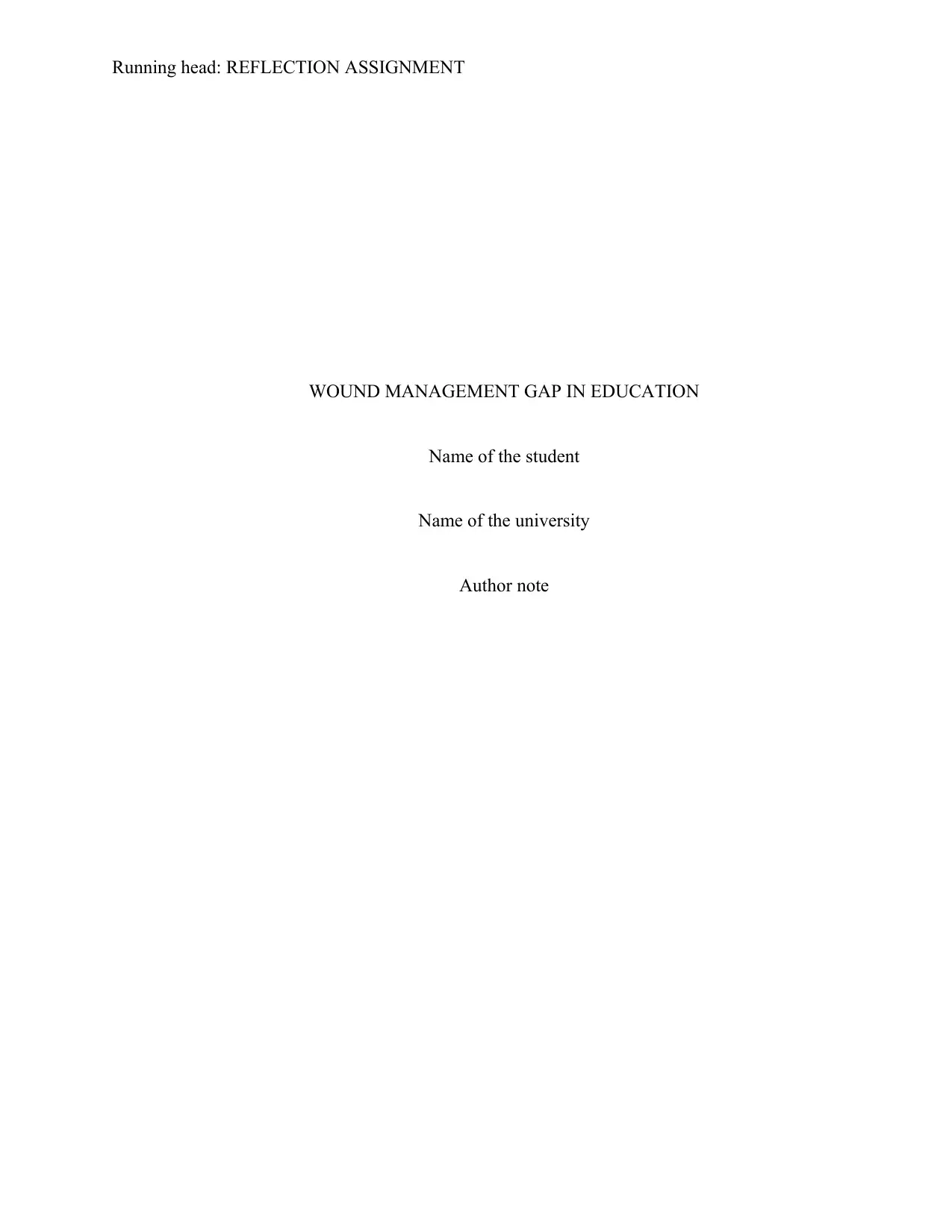
Running head: REFLECTION ASSIGNMENT
WOUND MANAGEMENT GAP IN EDUCATION
Name of the student
Name of the university
Author note
WOUND MANAGEMENT GAP IN EDUCATION
Name of the student
Name of the university
Author note
Paraphrase This Document
Need a fresh take? Get an instant paraphrase of this document with our AI Paraphraser
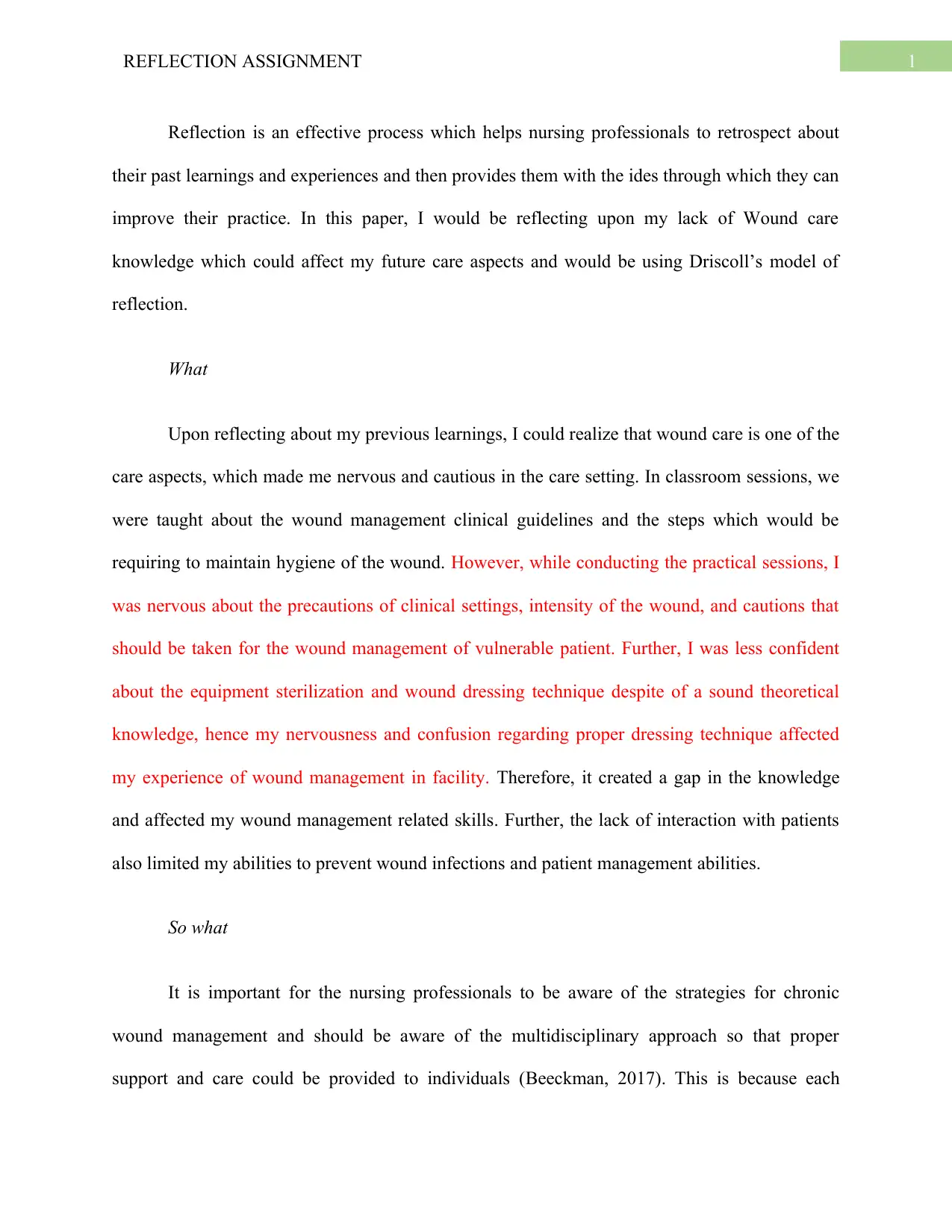
1REFLECTION ASSIGNMENT
Reflection is an effective process which helps nursing professionals to retrospect about
their past learnings and experiences and then provides them with the ides through which they can
improve their practice. In this paper, I would be reflecting upon my lack of Wound care
knowledge which could affect my future care aspects and would be using Driscoll’s model of
reflection.
What
Upon reflecting about my previous learnings, I could realize that wound care is one of the
care aspects, which made me nervous and cautious in the care setting. In classroom sessions, we
were taught about the wound management clinical guidelines and the steps which would be
requiring to maintain hygiene of the wound. However, while conducting the practical sessions, I
was nervous about the precautions of clinical settings, intensity of the wound, and cautions that
should be taken for the wound management of vulnerable patient. Further, I was less confident
about the equipment sterilization and wound dressing technique despite of a sound theoretical
knowledge, hence my nervousness and confusion regarding proper dressing technique affected
my experience of wound management in facility. Therefore, it created a gap in the knowledge
and affected my wound management related skills. Further, the lack of interaction with patients
also limited my abilities to prevent wound infections and patient management abilities.
So what
It is important for the nursing professionals to be aware of the strategies for chronic
wound management and should be aware of the multidisciplinary approach so that proper
support and care could be provided to individuals (Beeckman, 2017). This is because each
Reflection is an effective process which helps nursing professionals to retrospect about
their past learnings and experiences and then provides them with the ides through which they can
improve their practice. In this paper, I would be reflecting upon my lack of Wound care
knowledge which could affect my future care aspects and would be using Driscoll’s model of
reflection.
What
Upon reflecting about my previous learnings, I could realize that wound care is one of the
care aspects, which made me nervous and cautious in the care setting. In classroom sessions, we
were taught about the wound management clinical guidelines and the steps which would be
requiring to maintain hygiene of the wound. However, while conducting the practical sessions, I
was nervous about the precautions of clinical settings, intensity of the wound, and cautions that
should be taken for the wound management of vulnerable patient. Further, I was less confident
about the equipment sterilization and wound dressing technique despite of a sound theoretical
knowledge, hence my nervousness and confusion regarding proper dressing technique affected
my experience of wound management in facility. Therefore, it created a gap in the knowledge
and affected my wound management related skills. Further, the lack of interaction with patients
also limited my abilities to prevent wound infections and patient management abilities.
So what
It is important for the nursing professionals to be aware of the strategies for chronic
wound management and should be aware of the multidisciplinary approach so that proper
support and care could be provided to individuals (Beeckman, 2017). This is because each
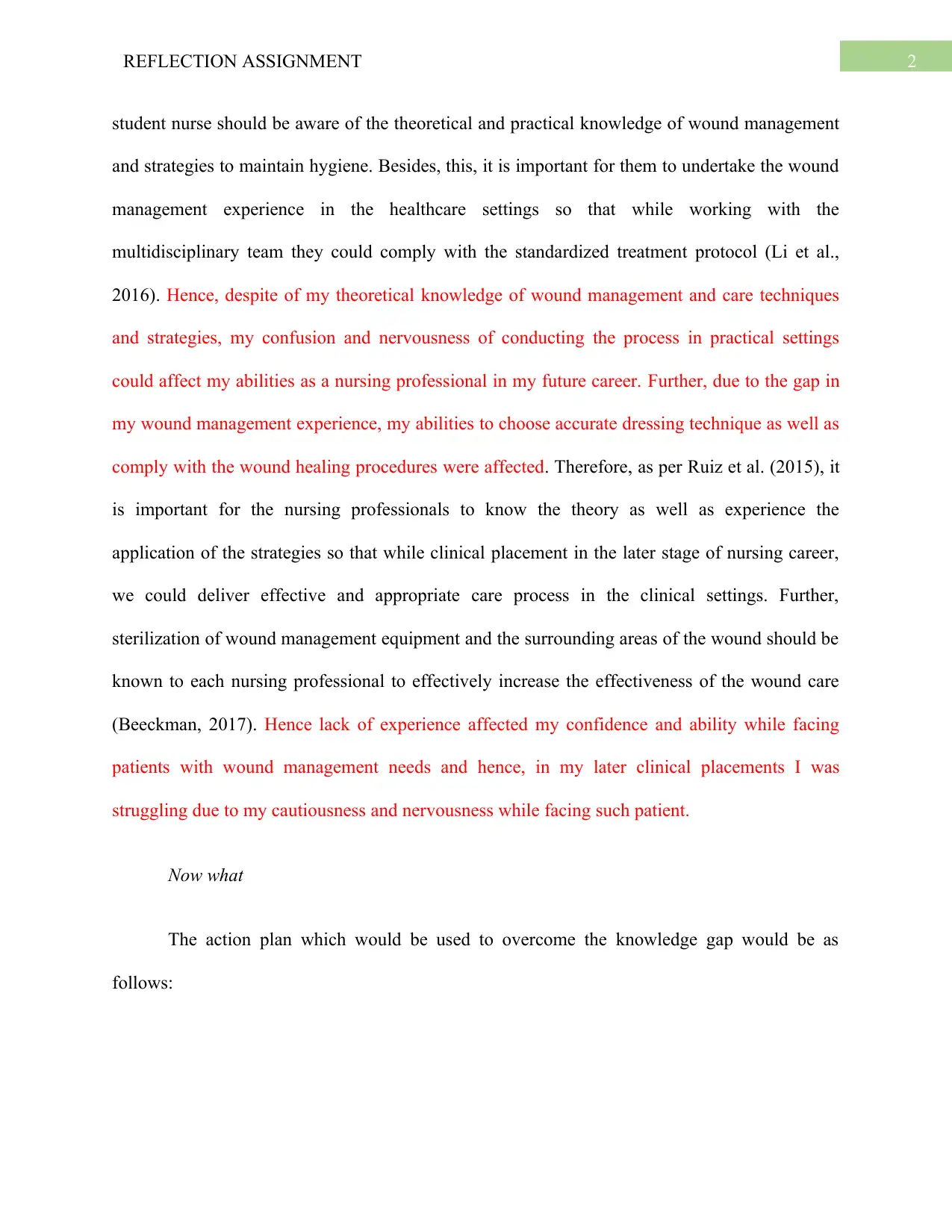
2REFLECTION ASSIGNMENT
student nurse should be aware of the theoretical and practical knowledge of wound management
and strategies to maintain hygiene. Besides, this, it is important for them to undertake the wound
management experience in the healthcare settings so that while working with the
multidisciplinary team they could comply with the standardized treatment protocol (Li et al.,
2016). Hence, despite of my theoretical knowledge of wound management and care techniques
and strategies, my confusion and nervousness of conducting the process in practical settings
could affect my abilities as a nursing professional in my future career. Further, due to the gap in
my wound management experience, my abilities to choose accurate dressing technique as well as
comply with the wound healing procedures were affected. Therefore, as per Ruiz et al. (2015), it
is important for the nursing professionals to know the theory as well as experience the
application of the strategies so that while clinical placement in the later stage of nursing career,
we could deliver effective and appropriate care process in the clinical settings. Further,
sterilization of wound management equipment and the surrounding areas of the wound should be
known to each nursing professional to effectively increase the effectiveness of the wound care
(Beeckman, 2017). Hence lack of experience affected my confidence and ability while facing
patients with wound management needs and hence, in my later clinical placements I was
struggling due to my cautiousness and nervousness while facing such patient.
Now what
The action plan which would be used to overcome the knowledge gap would be as
follows:
student nurse should be aware of the theoretical and practical knowledge of wound management
and strategies to maintain hygiene. Besides, this, it is important for them to undertake the wound
management experience in the healthcare settings so that while working with the
multidisciplinary team they could comply with the standardized treatment protocol (Li et al.,
2016). Hence, despite of my theoretical knowledge of wound management and care techniques
and strategies, my confusion and nervousness of conducting the process in practical settings
could affect my abilities as a nursing professional in my future career. Further, due to the gap in
my wound management experience, my abilities to choose accurate dressing technique as well as
comply with the wound healing procedures were affected. Therefore, as per Ruiz et al. (2015), it
is important for the nursing professionals to know the theory as well as experience the
application of the strategies so that while clinical placement in the later stage of nursing career,
we could deliver effective and appropriate care process in the clinical settings. Further,
sterilization of wound management equipment and the surrounding areas of the wound should be
known to each nursing professional to effectively increase the effectiveness of the wound care
(Beeckman, 2017). Hence lack of experience affected my confidence and ability while facing
patients with wound management needs and hence, in my later clinical placements I was
struggling due to my cautiousness and nervousness while facing such patient.
Now what
The action plan which would be used to overcome the knowledge gap would be as
follows:
⊘ This is a preview!⊘
Do you want full access?
Subscribe today to unlock all pages.

Trusted by 1+ million students worldwide
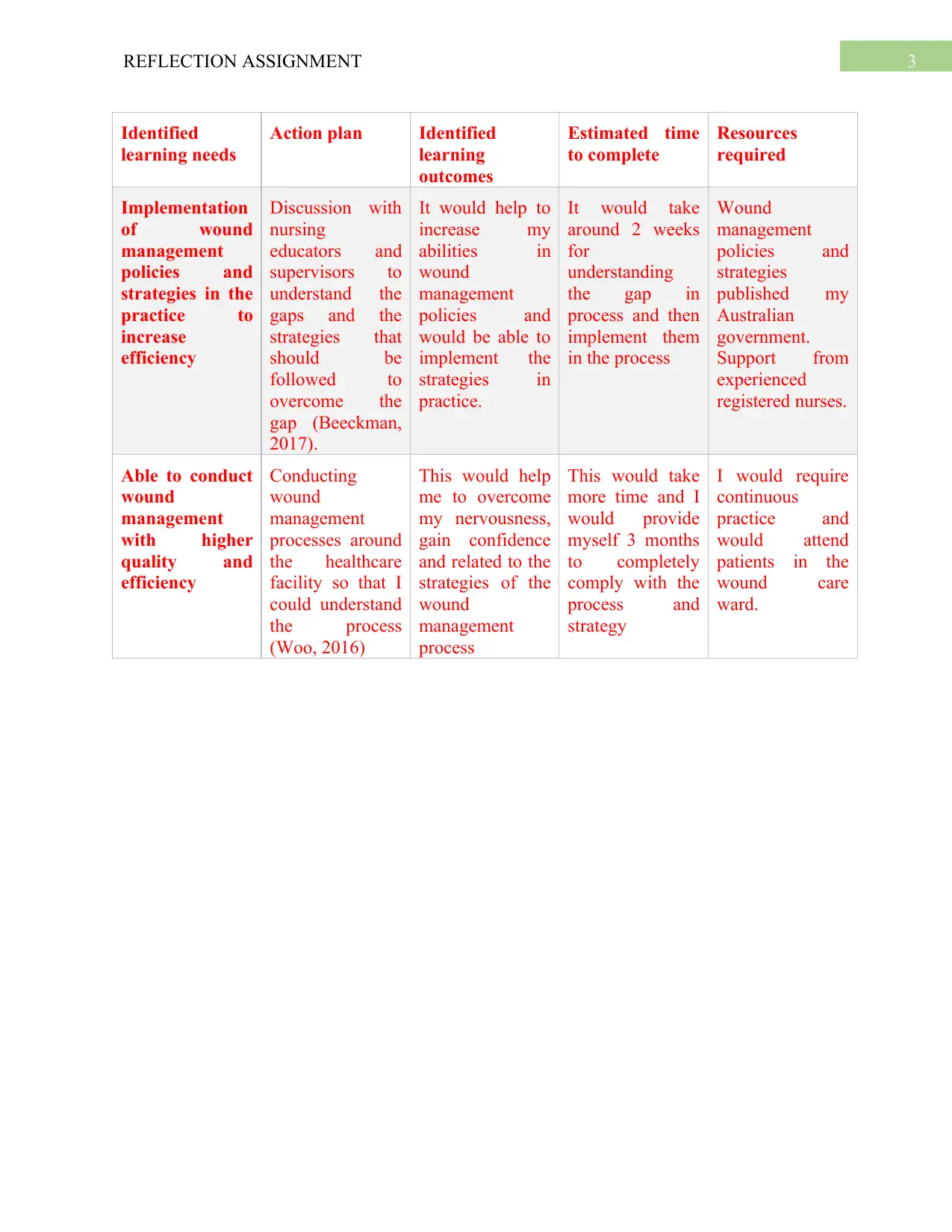
3REFLECTION ASSIGNMENT
Identified
learning needs
Action plan Identified
learning
outcomes
Estimated time
to complete
Resources
required
Implementation
of wound
management
policies and
strategies in the
practice to
increase
efficiency
Discussion with
nursing
educators and
supervisors to
understand the
gaps and the
strategies that
should be
followed to
overcome the
gap (Beeckman,
2017).
It would help to
increase my
abilities in
wound
management
policies and
would be able to
implement the
strategies in
practice.
It would take
around 2 weeks
for
understanding
the gap in
process and then
implement them
in the process
Wound
management
policies and
strategies
published my
Australian
government.
Support from
experienced
registered nurses.
Able to conduct
wound
management
with higher
quality and
efficiency
Conducting
wound
management
processes around
the healthcare
facility so that I
could understand
the process
(Woo, 2016)
This would help
me to overcome
my nervousness,
gain confidence
and related to the
strategies of the
wound
management
process
This would take
more time and I
would provide
myself 3 months
to completely
comply with the
process and
strategy
I would require
continuous
practice and
would attend
patients in the
wound care
ward.
Identified
learning needs
Action plan Identified
learning
outcomes
Estimated time
to complete
Resources
required
Implementation
of wound
management
policies and
strategies in the
practice to
increase
efficiency
Discussion with
nursing
educators and
supervisors to
understand the
gaps and the
strategies that
should be
followed to
overcome the
gap (Beeckman,
2017).
It would help to
increase my
abilities in
wound
management
policies and
would be able to
implement the
strategies in
practice.
It would take
around 2 weeks
for
understanding
the gap in
process and then
implement them
in the process
Wound
management
policies and
strategies
published my
Australian
government.
Support from
experienced
registered nurses.
Able to conduct
wound
management
with higher
quality and
efficiency
Conducting
wound
management
processes around
the healthcare
facility so that I
could understand
the process
(Woo, 2016)
This would help
me to overcome
my nervousness,
gain confidence
and related to the
strategies of the
wound
management
process
This would take
more time and I
would provide
myself 3 months
to completely
comply with the
process and
strategy
I would require
continuous
practice and
would attend
patients in the
wound care
ward.
Paraphrase This Document
Need a fresh take? Get an instant paraphrase of this document with our AI Paraphraser
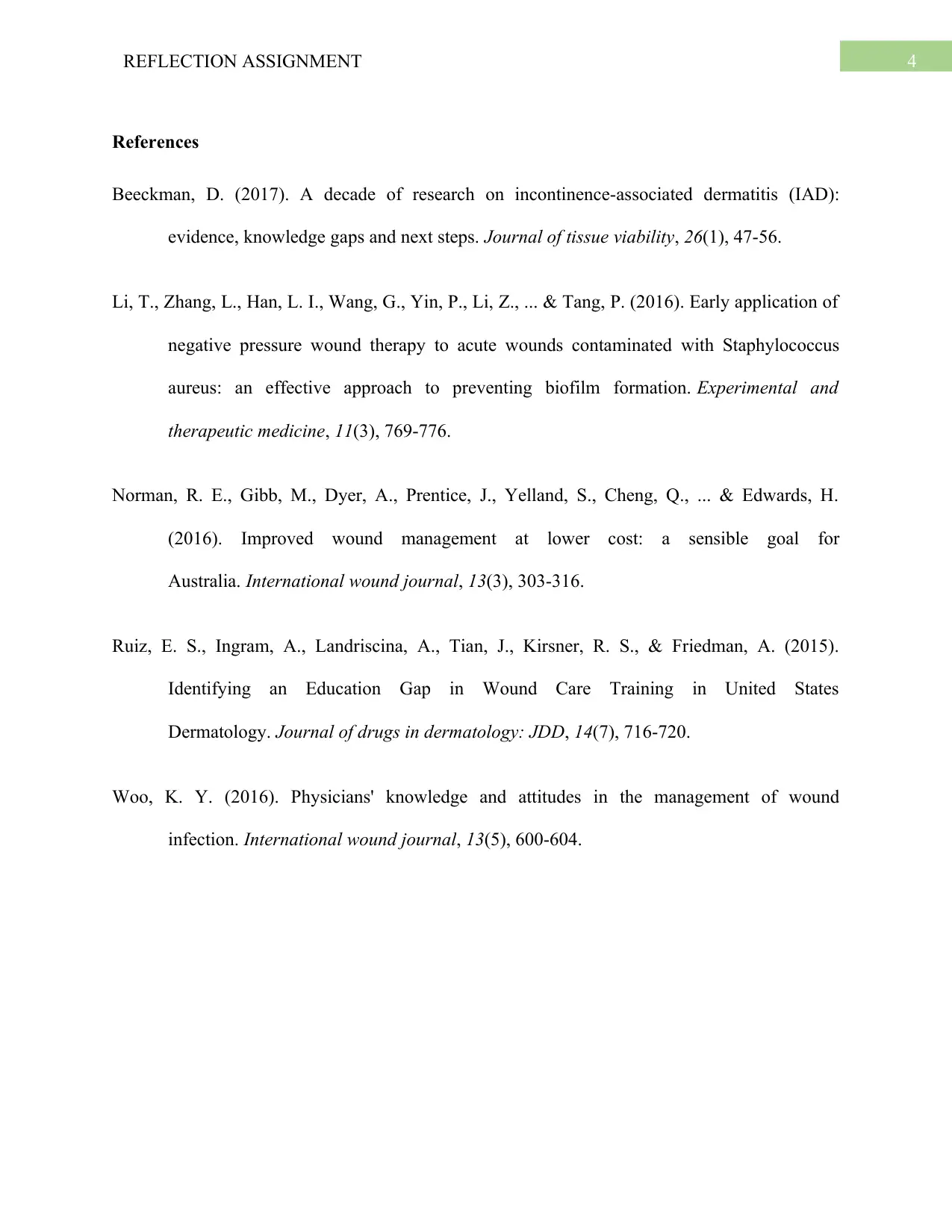
4REFLECTION ASSIGNMENT
References
Beeckman, D. (2017). A decade of research on incontinence-associated dermatitis (IAD):
evidence, knowledge gaps and next steps. Journal of tissue viability, 26(1), 47-56.
Li, T., Zhang, L., Han, L. I., Wang, G., Yin, P., Li, Z., ... & Tang, P. (2016). Early application of
negative pressure wound therapy to acute wounds contaminated with Staphylococcus
aureus: an effective approach to preventing biofilm formation. Experimental and
therapeutic medicine, 11(3), 769-776.
Norman, R. E., Gibb, M., Dyer, A., Prentice, J., Yelland, S., Cheng, Q., ... & Edwards, H.
(2016). Improved wound management at lower cost: a sensible goal for
Australia. International wound journal, 13(3), 303-316.
Ruiz, E. S., Ingram, A., Landriscina, A., Tian, J., Kirsner, R. S., & Friedman, A. (2015).
Identifying an Education Gap in Wound Care Training in United States
Dermatology. Journal of drugs in dermatology: JDD, 14(7), 716-720.
Woo, K. Y. (2016). Physicians' knowledge and attitudes in the management of wound
infection. International wound journal, 13(5), 600-604.
References
Beeckman, D. (2017). A decade of research on incontinence-associated dermatitis (IAD):
evidence, knowledge gaps and next steps. Journal of tissue viability, 26(1), 47-56.
Li, T., Zhang, L., Han, L. I., Wang, G., Yin, P., Li, Z., ... & Tang, P. (2016). Early application of
negative pressure wound therapy to acute wounds contaminated with Staphylococcus
aureus: an effective approach to preventing biofilm formation. Experimental and
therapeutic medicine, 11(3), 769-776.
Norman, R. E., Gibb, M., Dyer, A., Prentice, J., Yelland, S., Cheng, Q., ... & Edwards, H.
(2016). Improved wound management at lower cost: a sensible goal for
Australia. International wound journal, 13(3), 303-316.
Ruiz, E. S., Ingram, A., Landriscina, A., Tian, J., Kirsner, R. S., & Friedman, A. (2015).
Identifying an Education Gap in Wound Care Training in United States
Dermatology. Journal of drugs in dermatology: JDD, 14(7), 716-720.
Woo, K. Y. (2016). Physicians' knowledge and attitudes in the management of wound
infection. International wound journal, 13(5), 600-604.
1 out of 5
Related Documents
Your All-in-One AI-Powered Toolkit for Academic Success.
+13062052269
info@desklib.com
Available 24*7 on WhatsApp / Email
![[object Object]](/_next/static/media/star-bottom.7253800d.svg)
Unlock your academic potential
Copyright © 2020–2025 A2Z Services. All Rights Reserved. Developed and managed by ZUCOL.





